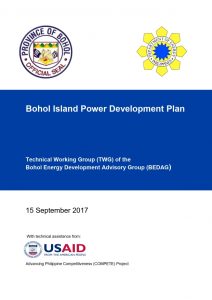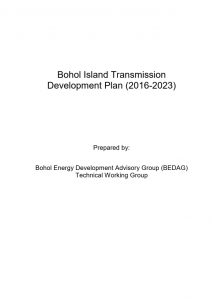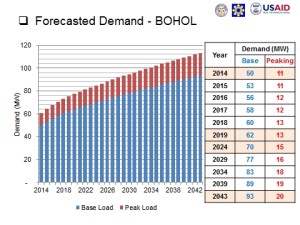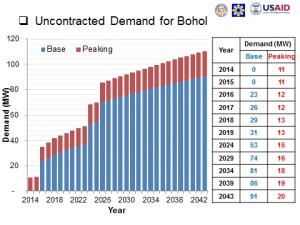The year 2013 was a turning point for the Island of Bohol. In a span of less than a month, the province was ravaged by a 7.2 magnitude earthquake and a record-breaking super typhoon Haiyan (local name: Yolanda). Although the latter did not make landfall in the island, it toppled transmission towers that connected Bohol to the main Visayas grid resulting to a month-long, province-wide power outage. The economic implications of such unfortunate events immediately moved the Local Government to take decisive actions, including the formulation of a long-term energy plan that will address the following goals for supply of electricity in the province:
- Ensure security of supply (available when needed);
- Ensure reliability and resiliency (climate-proofing) of supply; and
- Ensure affordability (least-cost).
In January 2014, Governor Edgardo Chatto issued Executive Order 13 series of 2014, which created the high-level Bohol Energy Development Advisory Group (BEDAG), an institutional mechanism for planning, implementing, and monitoring of power development initiatives in Bohol. The BEDAG is a multi-sector group composed of various representatives from the Local Government Unit, Private Sector, Academia, the National Grid Corporation of the Philippines (NGCP), and the three local Distribution Utilities (BOHECO I, BOHECO II, and BLCI). The BEDAG is co-chared by Governor Chatto and the Secretary of the Department of Energy (DOE). Together with its Technical Working Group (BEDAG-TWG), BEDAG is reponsible for preparing the Bohol Island Power Development Plan (BIPDP), which would eventually serve as the basis for the Province’s future power and energy investments. [It should be noted that the BIPDP, which includes the BIPSP will also be used as an input to the Department of Energy’s National Energy Master Plan.] The Bohol Island Power Development Plan shall consist of the following:
- Bohol Island Power Development Plan (BIPDP)
- Bohol Island Transmission Development Plan (BITDP)
- Distribution Development Plan(s) (DDP) of the
With technical assistance from the United States Agency for International Development – Advancing Philippine Competitiveness (USAID-COMPETE) Project, BEDAG initriated the formulation of the BIPDP that would address the goals set for the province. USAID-COMPETE provided capacity building support and technical advise to the BEDAG-TWG between February to November 2014.
Last November 2014, the BEDAG-TWG presented the Bohol Island Power Supply Plan (BIPSP) to the BEDAG. It was adopted and endorsed by the bEDAG to the Provincial Development Council, where it also received positive feedback. Revisions of the Power Supply Plan shall be done (if needed( with the integration of NGCP’s Transmission Development Plan and the three (3) Distribution Development Plans — completing the BIPDP. The BIPDP shall then, be endorsed by the Provincial Government following public consultations. It will be updated annually taking into consideration the future economic activities in the Province such as tourism growth, infrastructure developments, etc.
Elements of the Bohol Island Power Supply Plan:
Load Forecasts. In 2013 the Island of Bohol had a total demand of 67 MW, approximately 87% of which was normally sourced outside of Bohol through the Leyte-Bohol transmission line connecting the island to the main Visayas Grid.
With rigorous forecast model formulation and testing for forecast validity and accuracy, the BEDAG-TWG was able to come up with the demand forecasts shown in Figure 1. The conservative forecast shows that the Province of Bohol will have a total demand of 64 MW (53 MW Baseload and 11 MW Peak) in 2015. Note that the apparent decrease in demand from 2013 and 2015 can be attributed to the effects of the 2013 earthquake. Beyond 2015, Bohol’s demand is expected to increase to a total of 75 MW in 2019 and 113 MW by 2043.
Optimal Power Supply Mix. Using the load profile of Bohol and relevant power plant and cost data from representative baseload and peaking power plants, the BEDAG-TWG was able to come up with an optimal power supply mix that, when implemented, will ensure the least-cost power supply. For the combined requirements of the whole island of Bohol, the optimal power supply demand (in MW) should consist of 82% baseload and 18% peaking power plants. Practically all of its energy requirement (99.5%) shall be supplied from Baseload plants and only 0.5% shall be supplied from Peaking power plants. From these results, it can be concluded that contracting for baseload plants should be a priority. On the other hand, since the proportion of energy to be drived from peaking supply is very small, it may be sourced from WESM.
Power Supply Requirements. Using the results of the load forecasts and the optimal power supply mix, together with data on existing power supply contracts of the three Distribution Utilities, the BEDAG-TWG projected the total power requirements of Bohol up to CY 2043 shown in Figure 2.
Power Supply Strategy. In order to address the impending power supply requirements, the BEDAG has approved and endorsed the immediate contracting of short-term baseload power supply for the years 2016-2018 and long-term baseload power supply for 2019-2039 though a competitive procurement process similar and in conjuc\nction with the transparent and competitive joint procurement process being done by the Electric Cooperatives in R1+CAR and Region 8.
Concurrent with bilateral contracting of baseload power supply, the bEDAG will also undergo local resource assessment to identify possible natural resources taht can be utilized for power generation. Increasing the power supply sourced from within Bohol shall contribute to self-sufficiency and climate resiliency of Bohol’s power supply. The BEDAG has also endorsed the transmission plan presented by NGCP where an alternate Cebu-Bohol transmission link shall be provided to ensure connectivity of Bohol to the main Visayas Grid. This alternate transmission link will also allow export of excess power from Bohol if more generating resources are developed with the island.
The BEDAG has also resolved that all investments in power shall be subjected to scientific study and evaluation to ensure that they will be beneficial to the consumers of Bohol and are consistent with the goals, objectives and plans set out in the BIPDP.





good evening. may i know if the bohil island power development plan ( bipdp ) is available for download?
thank you
Hi Roger,
The Bohol Island Power Development Plan (BIPDP) is as of the moment still being formulated. We have referred your message to the people in-charge on the matter and advised them to communicate with you.
is it possible that i can ask or have a load curve in dauis bohol,? or the power consumption in kWh only in dauis bohol in year 2015, if possible monthly consumption in year 2015,? thanks.
Hi Jayasia,
It may be possible to obtain the data you require, however, we don’t have custody of such data. You might want to inquire to the Bohol Electric Cooperative I (BOHECO I), who has jurisdiction in supplying power to the Municipality of Dauis. You might be able to reach and obtain contact details from the BOHECO I Website.
Good Day!
I am Ann from Citicore Power, Inc.
Our company, CITICORE POWER, Inc. (CPI) engages in the development and operation of Renewable Energy Plants. Responding to government’s thrust and call for an accelerated RE development and sustainability, CPI committed in its pipeline a supply mix composed of Solar, Run of River and Biomass Plants.
CPI currently operates three Solar Power Plants: Next Gen Power Technology (Bataan), Silay Solar Power and First Toledo Solar Energy (Cebu).
CPI aligns itself with the Energy Industry’s mandate to provide continuous electricity supply to 90% of the country’s households by the year 2017. Cognizant of the opportunity to provide Renewable Energy technology systems – both traditional and hybrid, to grid connected areas and off-grid islands, CPI seeks out potential partnership with Distribution Utilities and Electric Cooperatives to deliver reliable and sustainable electricity supply.
Pursuant to this common goal, the CPI Business Development team hopes to meet and present with BEDAG to formally introduce our team and discuss possible partnership opportunities for power plant investments that are aligned with Bohol Island’s power development plan.
I would appreciate if we can get the contact person specifically for power project investments.
Many thanks and you may contact us anytime
Happy Holidays!
Can I ask for the annual load curve for entire Bohol for yr 2k16 and 2k17?
Your query has been routed to the personnel in charge. He/She may contact you through the email you provided. In the meantime, may we know what the data will be used for? Thank you.
To be used for our activity which regards to scheduling of power plant units under our power plant subject.
Info provided by our ODA-IR unit.
No available annual load curve. However, you might get the information you require through Bohol’s Distribution Utilities (DUs); the Bohol I Electric Cooperative, Incorporated (BOHECO I), Bohol II Electric Cooperative, Incorporated (BOHECO II), and the Bohol Light Company, Incorporated (BLCI).
Can i ask..What is the electric consumption in a month for tagbilaran city?
Hi Arjee, you might want to refer your query to the Bohol Light Company, Incorporated (BLCI). BLCI is the one supplying electricity to Tagbilaran City.
Can i ask..What is electric consumption in a year for tagbilaran city? I will used it in our steam power plant subject.
Hi Arjee, you might want to refer your query to the Bohol Light Company, Incorporated (BLCI). BLCI is the one supplying electricity to Tagbilaran City.
Can I ask about the Electric consumption for ubay? because i Will use it for my steam power plant subject.
Hi Mr. Ragudo, you may refer your query to Bohol II Electric Cooperative, Inc. (BOHECO II), which is the distribution utility serving the area. Thank you.
Hello,
Good day! I and groupmates are working on our thesis project and we will need some of the data from the following Hydropowerplants available in Bohol: Janopol hydroelectric plant in Balilihan town, Sevilla hydroelectric power plant both owned by Boheco 1-Sevilla Mini Hydro Corp., and Loboc hydroelectric plant in Loboc town owned by Sta. Clara International. Can I ask how can I have annual data with regards to its net head, turbine typing, potential energy production, and its plant capacity? Our study mainly focuses on optimizing the hydropower plants named above by using the Probability distribution function where we will try to determine and compare what turbine types are specifically assigned to the hydropower plants named abovementioned.
Hi Marienette, sorry we haven’t replied promptly due to the chaos brought by Typhoon Odette. We don’t have such data as you requested. You might want to contact the owners through their respective websites (BOHECO-I and Sta. Clara International Corporation), which has contact information published, for the information you require.
Hello, good day! I am writing a paper on the energy development of Bohol and its future direction of the use of renewable energy sources. Is there current data or current version available on this power development plan?
Hi Ms Vera
Thank you for your interest with the province of Bohol. This is the current plan. For updated data, you might want to reach the data sources, e.g. the power distribution utilities.